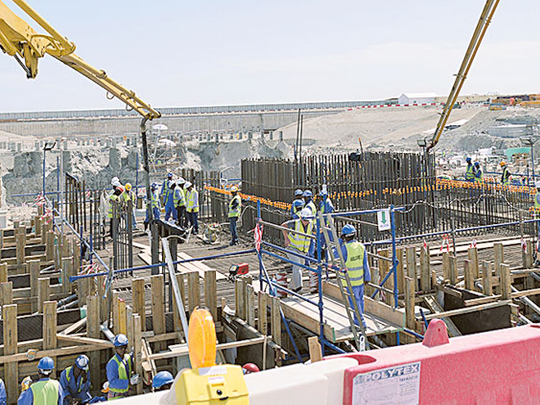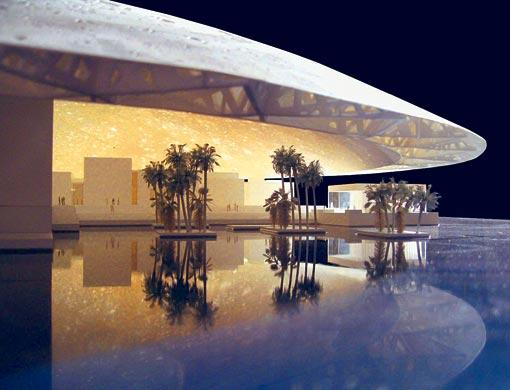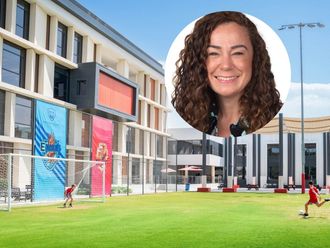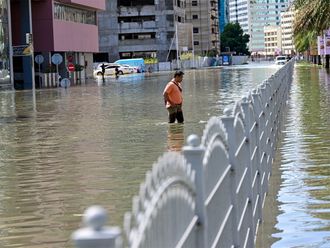
Abu Dhabi: Louvre Abu Dhabi, the first of three iconic museums on Saadiyat developed by the Tourism Development and Investment Company (TDIC), on Sunday announced the achievement of the first major milestone in the construction of the museum’s distinct dome.
Shaikh Sultan Bin Tahnoun Al Nahyan, Chairman of TDIC and Abu Dhabi Tourism and Culture Authority (TCA Abu Dhabi), alongside TDIC’s senior management, witnessed the pouring of the first concrete for one of the four piers that will hold the dome of the Louvre Abu Dhabi.
The dome which has a diameter of 180 metres and is expected to weigh more than 7,000 tonnes – almost the weight of the Eiffel Tower — will be supported at four points only. The dome will rest nine metres high at the entrance of the museum and will reach up to 30 metres high on the inside.
The design concept behind the laced dome is to reflect the interlaced palm trees traditionally used as roofing material in the region, allowing the sun to shine through like “a rain of light”.
It was designed so the roof primarily acts as a shading canopy to protect the outside plaza and building below from the heat of the sun, providing local comfort and reducing building energy consumption.
The museum, which will be surrounded with water, gives the illusion of a floating structure. Work on the dome is expected to be complete by the end of 2014.
The construction of the Louvre Abu Dhabi, set to open in Saadiyat Cultural District in 2015, was awarded to Arabtec-led joint venture with Constructora San Jose SA and Oger Abu Dhabi LLC in January this year.
Louvre Abu Dhabi has achieved major developmental milestones with the finishing of the building’s detailed design and the completion of the infrastructure, which encompassed marine, excavation, piling and substructure works.
Mubarak Hamad Al Muhairi, Managing Director of TDIC, said: “We’re delighted to witness the first concrete pour for the foundation that is going to hold up the unique dome of Louvre Abu Dhabi. This is an important time for us because it’s symbolic of moving into a new construction stage and, most importantly, getting another step closer towards realising our landmark project. This is a world-class museum with a one-of-its-kind design and TDIC is closely monitoring its development.”
A temporary platform in the sea, where the entire building will be constructed, was built in 2009 to allow all work to take place in a dry environment. Upon completion of the building, including the marine works, the 40-metre high concrete walls currently built in the sand will be removed to allow seawater to flow in gradually.
More than 4,000 steel and reinforced concrete piles – a total volume of 21,000 cubic metres of concrete – were driven into the ground to serve as a base for the Louvre Abu Dhabi building.
The final stage includes marine works and removal of temporary land platforms which will be completed in 2015 when this world-class building transforms into an island of its own.
Designed by Pritzker-prize winning architect Jean Nouvel, the Louvre Abu Dhabi will encompass 9,200 square metres of art galleries. The 6,681-square-metre Permanent Gallery will house the museum’s permanent collection taking the visitor through a universal journey from the most ancient to contemporary through art works from different civilisations. The Temporary Gallery will be a dedicated space of 2,364 square metres presenting temporary exhibitions of international standards.
The Louvre Abu Dhabi will be one of the premier cultural institutions located in the heart of the Saadiyat Cultural District unprecedented in scale and scope.
These feature Zayed National Museum, which will open in 2016, and Guggenheim Abu Dhabi, which will open in 2017 — both also designed by world-renowned Pritzker-prize winning architects. All this adds to the appeal of Saadiyat which exudes an exclusive lifestyle through the island’s high-end residential, leisure, cultural and tourism facilities.













